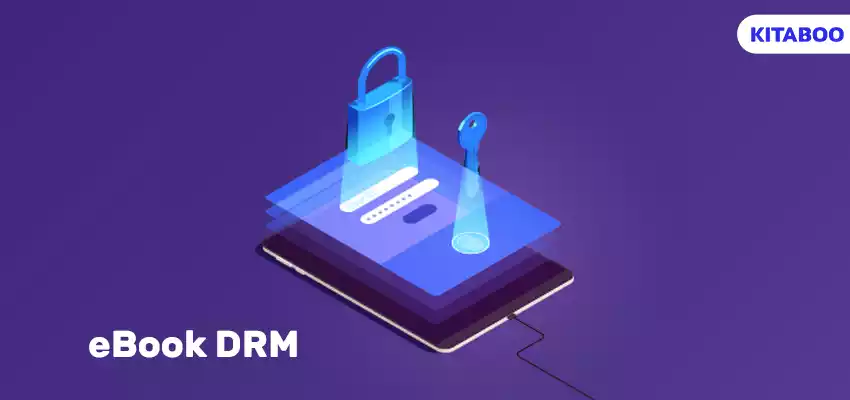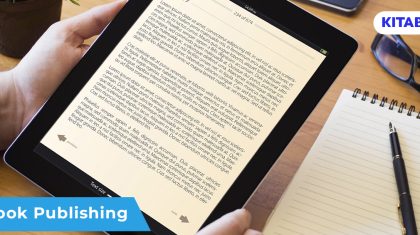
Unlock the Secrets of eBook DRM: Secure Your Digital Library
Digital Rights Management, or DRM, is a technology-driven solution to safeguard digital assets against various forms of illegitimate access. The advancements in eBook creation technology have enabled publishers to distribute their content globally. However, it has also made it difficult to restrict the unauthorized copying and redistribution of intellectual property.
These forms of digital piracy pose various challenges for publishers, content creators, and digital library owners.
Therefore, it is critical to protect your digital library using eBook DRM. Digital textbook platforms like KITABOO offer convenient deployment of DRM to ensure that your eBooks are protected against unauthorized use.
In this article, we shall look at the techniques that DRM leverages to restrict the impact of digital piracy on your assets. Let’s dive in!
Table of Contents
I. Six Techniques to Secure Your Digital Library with eBook DRM
- Limiting Content Access to Approved Devices
- Content Geo-Restriction
- Limited Time Licensing
- Prevention of Replication
- Lending or Download Restrictions
- Online Authentication
II. Conclusion
Six Techniques to Secure Your Digital Library with eBook DRM
Digital piracy results in direct losses in revenue due to a reduction in official sales. Furthermore, there may be issues to contend with when your eBooks include sensitive third-party data or intellectual property.
DRM-free content is left unguarded in this scenario, and you could end up breaching confidentiality or licensing agreements. Therefore, publishers must be aware of the various strategies to protect their digital assets using eBook DRM.
Here are six effective techniques to secure your digital library:
1. Limiting Content Access to Approved Devices
DRM protection prevents users from accessing your digital assets on unauthorized devices. In other words, it ensures that users can only access the content on approved devices, such as:
- A dedicated eReader device
- A general-purpose device with an approved eReader app installed
The approved device or application to read your content on depends on your choice of eBook publishing platform. For instance, if you publish your content on Amazon, it will either be read on a Kindle device or the Kindle app.
Alternatively, with platforms like KITABOO, you can use a pre-existing cross-platform interactive eBook reader or build your own eReader application. In the latter case, any device compatible with your custom application can be treated as an approved device.
Thus, you can offer your users the freedom to choose from a range of approved devices while simultaneously protecting your digital library.
2. Content Geo-Restriction
Geo-restriction prevents content access from unauthorized or unapproved geographical locations. DRM can prohibit access to your digital library based on the user’s location, indicated by their IP address.
This geo-restriction feature may be required for your content in the following scenarios:
- If users try to access your content from countries where you do not have distribution rights.
- When your library includes external content that is either integrated with your eBooks or accessible via embedded links, you may not have permission to distribute this third-party content in specific geographies, making geo-restriction a necessity.
In all such cases, DRM can protect your content by implementing location-based lockouts for your digital library.
3. Limited Time Licensing
DRM allows you to permit limited-time access to your content through a temporary license instead of a permanent one. Issuing such limited-time licenses can be useful in the following cases:
You wish to implement a subscription-based model for your digital library.
- Your content will receive regular updates, and these updates need to be made accessible to your existing readers periodically.
- The rights to third-party content included with your offerings have time-bound licenses.
With the inclusion of eBook DRM, you can make your digital assets available to your readers for a specific interval. After this interval expires, DRM shall restrict access to your content until the license is renewed. This feature is particularly useful for publishers managing large digital libraries.
4. Prevention of Replication
Deployment of DRM prevents copyright breaches by disabling printing and copy-pasting of your digital content. Tackling both these replication methods is vital to impede content piracy, preventing financial losses, unlawful distribution, and plagiarism.
DRM also allows you to implement such restrictions to varying degrees. For instance, you could disallow printing of your content altogether or allow a fixed number of prints for a registered user.
A similar strategy works for copy-paste as well. You can disable copy-paste or place a limit on the number of words that can be copied from your eBooks at one time. This will make content duplication substantially harder for miscreants while offering reasonable flexibility to the registered users of your digital library.
5. Lending or Download Restrictions
DRM enables digital libraries to lend their content in a controlled manner by restricting the number of copies that can be borrowed. In other words, you can control the number of concurrent users that can access the same eBook from your library.
DRM can also regulate the number of devices that a single user can access your content from. Therefore, it offers you control over who can borrow content from your digital library and how and where they can access it.
6. Online Authentication
Online authentication is a DRM technique in which the reader is required to authenticate their digital copy or device using an internet connection. This authentication can be required constantly or at regular intervals.
Constant authentication, otherwise known as persistent online authentication, requires the user to stay connected to the Internet. While this type of measure is highly effective at preventing unauthorized content use, it is also user-unfriendly.
A better alternative would be to require authentication at regular intervals or when downloading an eBook copy. This type of online authentication would allow your legitimate readers to use your content even when offline while your digital library remains DRM-protected.
Conclusion
With the help of DRM, you can build a secure digital library. Through its various features, DRM protects your content against piracy, offering you better control over how, when, and by whom your eBooks are accessed. Furthermore, through options like limited-time licenses and geo-restriction, DRM ensures seamless and compliant content distribution.
Overall, DRM is a must-have feature to create an optimal user experience for your readers without compromising on content security. With KITABOO, you can seamlessly integrate eBook DRM into your digital publishing workflow and safeguard your digital library today!
To know more, connect with us now!
Also check:
Digital Textbook Platform for K12 Publishers
Digital Textbook Platform for Associations & Societies
Digital Textbook Platform for Trade Publishers
Discover how a mobile-first training platform can help your organization.
KITABOO is a cloud-based platform to create, deliver & track mobile-first interactive training content.



